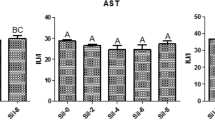Abstract
In this investigation, the efficacy of a single intraperitonealinjection of either flumequine or oxytetracycline hydrochloride to preventoutbreak of atypical Aeromonas salmonicida infection ingoldsinny wrasse, Ctenolabrus rupestris, following stresswas studied. Six groups of goldsinny wrasse, each of 50 individuals, weretreated with an intraperitoneal injection of either propylene glycol : saline(50 : 50), 200 mg kg−1 of oxytetracycline or 50mg kg−1 of flumequine dissolved in propyleneglycol : saline (50 : 50). Three days following medication the fish in allgroups were stressed by an intraperitoneal injection of prednisolone acetate(0.05 ml) and a rise in seawater temperature from 9 to 11°C. Mortality was observed daily for 21 days. Flumequine wasthe more effective with a mean cumulative mortality of 5% compared tooxytetracycline with 54%. The mean cumulative mortality in the unmedicatedcontrol groups was 84%. Bacterial examination of kidneys from dead fishconfirmed the presence of atypical A. salmonicida as theprobable cause of death. Minimum inhibitory concentration (MIC) values forflumequine and oxytetracycline against the isolated A.salmonicida were determined to 0.13 μgml−1, and 2.0 μg ml−1,respectively.
Similar content being viewed by others
References
Amend D.F. 1981. Potency testing of fish vaccines. Development in Biological Standardisation49: 447–454.
Bjordal A. 1990. Sea lice infection on farmed salmon: possible use of cleaner fish as an alternativemethod for de-lousing. Canadian Technical Report on Fish and Aquatic Science 1761: 85–89.
Blaser J., Stone B.B., Groner M.C. and Zinner S.H. 1987. Comparative study with enoxacin and netilmicin in a pharmacodynamic model to determine importance of ratio of antibiotic peak concentration to MIC for bactericidal activity and emergence of resistance. Antimicrobial Agents and Chemotheraphy 31: 1054–1060.
Deady S., Varian S.J.A. and Fives J.M. 1995.The use of cleaner-fish to control sea lice on 2 Irish salmon (Salmo salar) farms with particular reference to wrasse behaviour in salmon cages. Aquaculture 131: 73–90.
Doi A.M., Stoskopf M.K. and Lewbart G.A. 1998.Pharmacokinetics of oxytetracycline in the red pacu (Colossoma brachypomum) following different routes of administration. Journal of Veterinary Pharmacology and Therapeutics 21: 364–368.
Elston R., Drum A.S. and Bunnell P.R.1995a. Furunculosis injection model for drug efficacy testing of seawater-adapted Atlantic salmon. Journal of Aquatic Animal Health 7: 16–21.
Elston R., Drum A.S. and Bunnell P.R. 1995b. Efficacy of orally administeredDifloxacin for the treatment of furunculosis in Atlantic salmon held in seawater. Journal of Aquatic Animal Health 7: 22–28.
Grondel J.L., Nouws J.F.M., De Jong M., Schutte A.R. and Driessens F. 1987. Pharmacokinetics and tissuedistribution of oxytetracycline in carp, Cyprinus caprio L., following different routes of administration. Journal of Fish Diseases 10: 153–163.
Hiney M., Coyne R., Kerry J., Pursell L., Samuelsen O.B. and Smith P. 1995. Failure of flumisolbath treatment during commercial transport of Atlantic salmon smolts to prevent the activation of stress inducible furunculosis. Aquaculture 136: 31–42.
Inglis V., Richards R.H., Varma K.J., Sutherland I.H. and Brokken I.S. 1991.Florfenicol in Atlantic salmon, Salmo salar L., parr: tolerance and assessment of efficacy against furunculosis. Journal of Fish Diseases 14: 343–351.
Laidler L.A., Treasure J.W., Grant A.N. and Cox D.I. 1999. Atypical Aeromonassalmonicida infection in wrasse (Labridae) used as cleaner fish of farmed Atlantic salmon, Salmo salar L., in Scotland. Journal of Fish Diseases 22: 209–213.
McCarthy D.H. 1977. Some ecological aspects of the bacterial fish pathogenAeromonas salmonicida. Aquatic Microbiology SAB Symp 6: 299–324.
Nordmo R., Holth Riseth J.M., VarmaK.J., Sutherland H.I. and Brokken E.S. 1998. Evaluation of florfenicol in Atlantic salmon, Salmo salar L.: efficacy against furunculosis due to Aeromonas salmonicida and cold water vibriosis due to Vibrio salmonicida. Journal of Fish Diseases 21: 289–297.
Samuelsen O.B. and Lunestad B.T. 1996. Bath treatment, an alternative method for the administration ofthe quinolones flumequine and oxolinic acid to halibut Hippoglossus hippoglossus, and the in vitro antibacterial activity of the drugs against some Vibrio sp. Diseases of Aquatic Organisms 27: 13–18.
Samuelsen O.B., Hjeltnes B. and Glette J.1998. Efficacy of orally administered florfenicol in the treatment of furunculosis in Atlantic salmon. Journal of Aquatic Animal Health 10: 56–61.
Samuelsen O.B., Torkildsen L., Husgard S. and Bergh Ø. 2000. The efficacy of asingle i.p. injection of flumequine in the treatment of systemic vibriosis in corkwing wrasse (Symphodus melops). Journal of Aquatic Animal Health 12: 324–328.
Samuelsen O.B. and Ervik A. 2001. Absorption, tissue distribution andexcretion of flumequine and oxolinic acid in corkwing wrasse (Symphodus melops) following a single intraperitoneal injection or bath treatment. Journal of Veterinary Pharmacology and Therapeutics 24: 111–116.
Stamm J.M. 1989. In vitroresistance by fish pathogens to aquacultural antibacterials, including the quinolones difloxacin (A-56619) and sarafloxacin (A-56620). Journal of Aquatic Animal Health 1: 135–141.
Treasurer J.W. and Laidler L.A. 1994. Aeromonassalmonicida infection in wrasse (Labridae) used as cleaner fish on an Atlantic salmon, Salmo salar L., farm. Journal of Fish Diseases 17: 155–161.
Tsoumas A., Alderman D.J. and Rogers C.J. 1989. Aeromonas salmonicida:development of resistance to 4-quinolone antibacterials. Journal of Fish Diseases 12: 493–507.
Washington J.A.II 1985. Susceptibility Tests: agar dilution. In: Lennette E.H., Balows A., Hausler W.J. Jr and Shadomy H.J. (eds), Manual of Clinical Microbiology. 4th edn. American Society for Microbiology, Washington, DC, USA, pp. 967–971.
Author information
Authors and Affiliations
Rights and permissions
About this article
Cite this article
Samuelsen, O.B., Ervik, A., Torkildsen, L. et al. The efficacy of a single intraperitoneal injection of either flumequine or oxytetracycline hydrochloride in prevention of outbreaks of atypical Aeromonas salmonicida infection in goldsinny wrasse, Ctenolabrus rupestris L., following stress.. Aquaculture International 10, 257–264 (2002). https://doi.org/10.1023/A:1022187627019
Issue Date:
DOI: https://doi.org/10.1023/A:1022187627019




